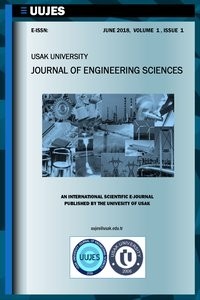INVESTIGATION OF THE WATER ABSORPTION PROPERTIES OF PULTRUDED HYBRID COMPOSITE PROFILES
INVESTIGATION OF THE WATER ABSORPTION PROPERTIES OF PULTRUDED HYBRID COMPOSITE PROFILES
Pultrusion is a continuous process for the manufacture of fiber reinforced polymer matrix composite products having a constant cross section, such as rod stock, structural shapes, beams, channels, pipe and tube. Pultruded profile products have high structural integrity and mechanical properties. The water absorption characteristics of composite materials give serious concern, especially for their potential outdoor applications. It is also known that having a high water absorption tendency has negative effects on the mechanical, physical, chemical and optical properties of composite materials. This is why; it is undesirable that the polymer matrix, which is used in the production of the composite profiles by the pultrusion method, has high water absorption values. Fiber content is also a leading parameter and has a significant influence on the mechanical properties of composite materials. In this study; the water absorption characteristics and fiber contents of pultruded glass-carbon fiber reinforced polyester and vinylester hybrid composite profiles were experimentally investigated. Water absorption tests were performed by immersing composite specimens into water conditions according to ASTM D 570 standard. The fiber contents of composite specimens were determined by calcination method according to TS 1177 EN ISO 1172 standard. The results obtained from the experiments were analyzed and explained with necessary comments.
___
- 1. Gu H. Behaviours of glass fibre-unsaturated polyester composites under seawater environment. Materials and Design, 2009;30: 1337-1340.
- 2. Bonniau P and Bunsell AR. A comparative study of water absorption theories applied to glass epoxy composites. Journal of Composite Materials, 1981;15: 272-293.
- 3. Thomason JL. The interface region in glass fibre-reinforced epoxy resin composites: 2, Water absorption,voids and the interface. Composites, 1995;26: 477-485.
- 4. Kootsookos A and Mouritz AP. Seawater durability of glass and carbon polymer composites. Composites Science and Technology, 2004;64: 1503-1511.
- 5. Errajhi OAZ, Osborne JRF, Richardson MOW and Dhakal HN. Water absorption characteristics of aluminised E-glass fibre reinforced unsaturated polyester composites. Composite Structures, 2005;71: 333-336.
- 6. Md Akil H, Cheng LW, Mohd Ishak ZA, Abu Bakar A and Abd Rahman MA. Water absorption study on pultruded jute fibre reinforced unsaturated polyester composites. Composites Science and Technology, 2009;69: 1942-1948.
- 7. Maslinda AB, Abdul Majid MS, Ridzuan MJM, Afendi M and Gibson AG. Effect of water absorption on the mechanical properties of hybrid interwoven cellulosic-cellulosic fibre reinforced epoxy composites. Composite Structures, 2017;167: 227-237.
- 8. Dhakal HN, Zhang ZY and Richardson MOW. Effect of water absorption on the mechanical properties of hemp fibre reinforced unsaturated polyester composites. Composites Science and Technology, 2007; 67: 1674-1683.
- 9. Athijayamani A, Thiruchitrambalam M, Natarajan U, Pazhanivel B. Effect of moisture absorption on the mechanical properties of randomly oriented natural fibers/polyester hybrid composite. Materials Science and Engineering A, 2009;517: 344-353.
- 10. Renliang M, Weiwei L, Momo H, Xiaojing L, Ming F. Enhancing strength and toughness of carbon fibers reinforced rigid polyurethane composites with low fiber content. Polymer Testing, 2018;71: 156-162.
- 11. Yucheng Z, Mingyang C, Xin Z, Haixiao H, Dongfeng C, Shuxin L. Hygrothermal durability of glass and carbon fiber reinforced composites – Acomparative study. Composite Structures, 2019;211: 134-143.
- Başlangıç: 2018
- Yayıncı: Uşak Üniversitesi
Sayıdaki Diğer Makaleler
INVESTIGATION OF THE WATER ABSORPTION PROPERTIES OF PULTRUDED HYBRID COMPOSITE PROFILES
EVALUATION OF FATIGUE PARAMETERS ON POLYMER MODIFIED BITUMENS
Babatunde BOLASODUN, Ademola AGBELEYE, Richard DAY
Mg/Zn COMPOSITES PRODUCED BY MECHANICAL ALLOYING AND HOT PRESSING AND IN-VITRO BIODEGRADATION
Simay ERDİBİL, Serap CESUR, Rasim İPEK
NUMERICAL SOLUTION TECHNIQUES FOR CURRENT AND VOLTAGE VARIABLES IN ELECTRICAL (RLC) CIRCUITS
Falade KAZEEM, Ayodele VİCTORİA
COMPARISON OF CLASSIFIERS FOR THE RISK OF OBESITY PREDICTION AMONG HIGH SCHOOL STUDENTS
